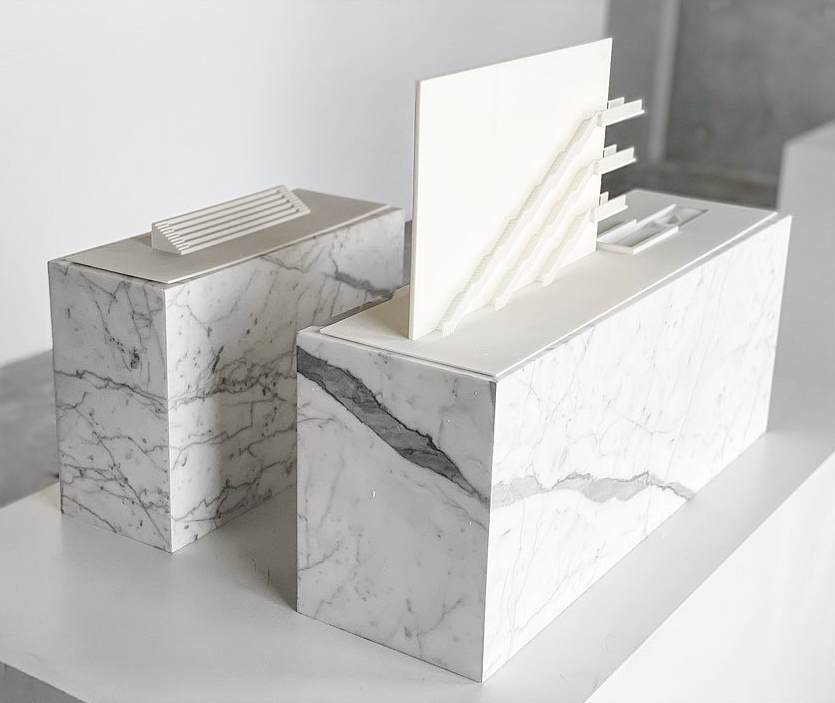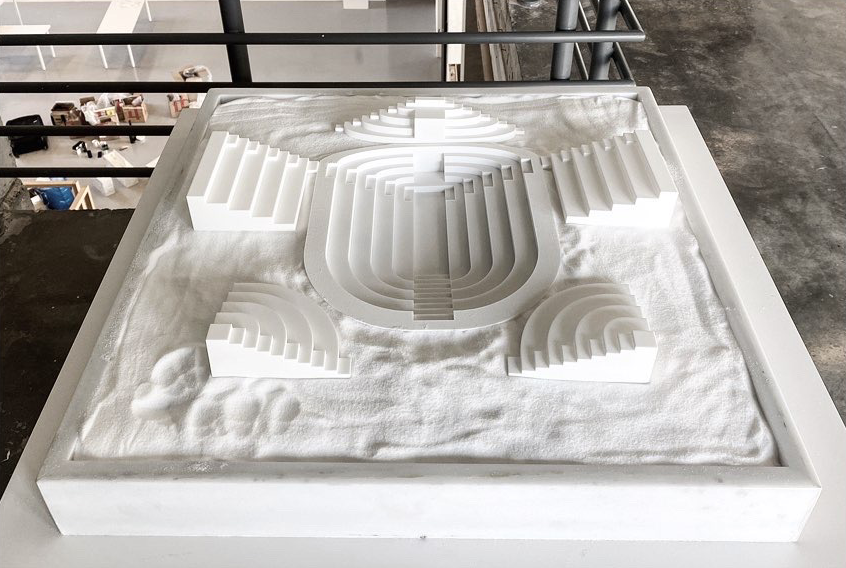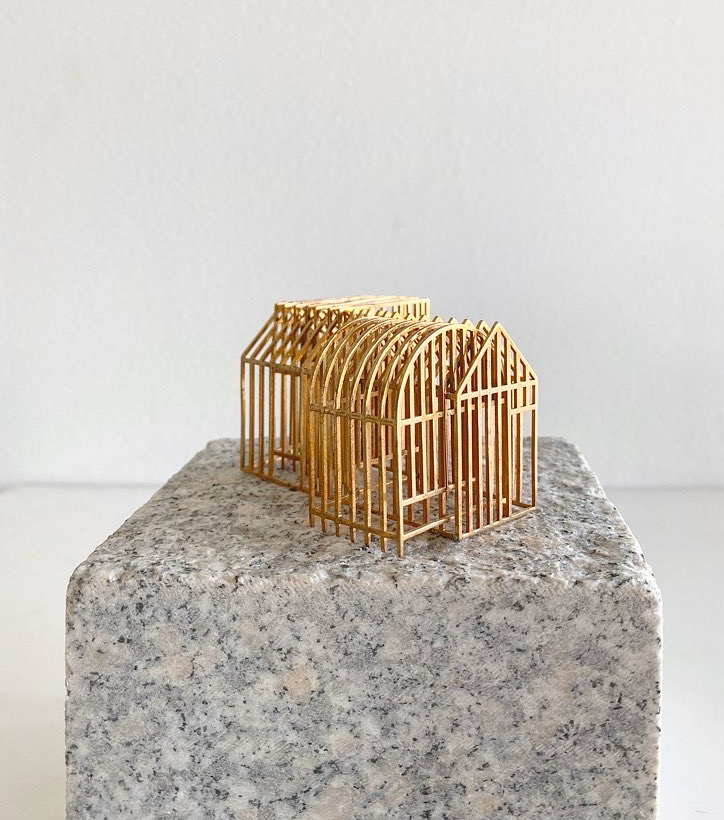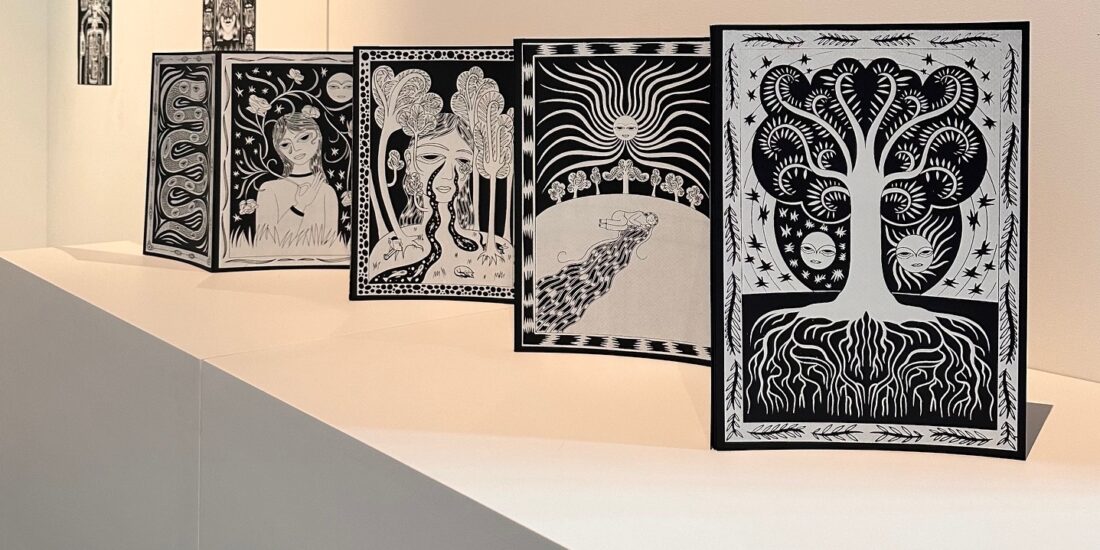Small Architecture Strikes Big
Thomas Modeen and Mayssa Al Mumin of Architects Independent exhibit a selection of their work titled Small Architecture, at the Fire Station Museum. The exhibition is ongoing till February 29 and gives an insight into the interminable body of work by an architect who loves to imagine and create, ceaselessly.
If you have read an earlier interview with the architects behind Architects Independent in SCALE, you will not be surprised by the vast variety of products and artifacts on display at the Fire Station Museum. But if you do not know Dr. Thomas Modeen and Maysaa AlMumin be ready to be transported to esoteric bursts of creative ideas expressed in products, from homeware to jewellery, to buildings in response to the architects’ angst at certain persisting conditions and art forms and short films that throw light on the philosophy behind their practice.


Top: A birds-eye view of the ground floor of the exhibition which shows the furniture designed by the design firm; the all-encompassing dining table and the bookcase beside it. Bottom: The dining table shows the A6 notepad collection of Thomas, where all the ideas are first sketched
The work exhibited has been realized over the past decade or so, and it transcends, or smudges the partitions of usual categories, separating the common classifications defining the various forms of design and art practice (architecture, interior design, product design, sculpture). “The work is united in its interest in the rituals – both formal and mundane – according to which we define ourselves, the emotive catalysts that generate such practices, the sensorial qualities of related artifacts and endeavors, and the associated fabrication methods according to which such designs are made. The exhibition includes works from Johan Granberg, Maryam Al-Homaid, Ghadah Alkandari, Bouthayna Al-Muftah Hadeer Omar and Fatma Al-Remaihi,” explains Thomas of the exhibition titled Small Architecture.
- Portraits of Thomas Modeen and Mayssa Al Mumin, sketched by Fatima Al-Remaihi.
Under the factory-like settings of the Fire Station Museums Workshop 4, the products and architecture that Thomas has dreamt of, sketched in his notepad the appendage that is as permanent as the black garments that Thomas dons, and then finally produced, are exhibited in immaculate order, almost in contrast to the architects thought process that is always in rapid succession with one product taking shape much before the other is complete, but each of them, precise and detailed in its design and execution. In a short portrayal of Thomas in a movie titled, A Strangely Familiar Oddity by Johan Granberg, students, colleagues, and co-workers struggle to put into words the factors that define Thomas and come short, and Maysaa comes close as she says: “design is innate to who he is”.
SCALE engages Thomas Modeen, the restless creator who can never really stop creating or imagining, and sketching, in a dialogue that gives us an interesting perspective of the man behind the storm of philosophies that give rise to more creative ideas and final products.
- What do you mean by Small Architecture and how does it fit the context of the exhibition?
The terms ‘small architecture’ is somewhat an inside pun, as our former company in London was called Small Architecture. But, in this instance, it refers to how we approach the design work we do. We consider it from a somewhat ‘architectural’ perspective, entailing that everything is questioned, from the conceptual premises from which a design proposal is instigated (the questions we pose, the theoretical frameworks we apply), to the methods through which it is realized (materials, means of fabrication, available craftsmanship, budget, etc.). Here details, in every sense of the word and regardless of the scale of the design we’re working on, matter…
A summary, of sorts, encapsulating this attitude to design is a related ‘lightbulb’ joke which goes:
- How many architects does it take to change a lightbulb!
- Does it have to be a lightbulb?
- Artifacts by Architects Independent
- The Blablack Light, a tablelamp with ultra-matte black paint.
…The pursuit of answers is a perpetual process and to some degree, a design is never really concluded.
Recognizing the value of the small, the detail, the nuance in any design one is involved with, regardless of scale or complexity, is fundamental for its success.
- Which of the artifacts exhibited here fall under the category of sensory stimulants and emotive embodiments?
In some sense, they all do, including the architecture…
I believe that we form an emotional attachment that inevitably contains an innate sensorial presence with any worthwhile artifact or space.
Just consider how difficult it can become to discard even trivial objects when one moves house.
We attach memories to things, that inevitably become mnemonic triggers, be these old baby toys, a restaurant receipt from a memorable evening with a dear friend, one’s first favorite sneakers, and more…
- Jewellery pieces and other utility artifacts like the Fruit-Boot-Dispenser, the Egg Holder, the Ocular Pepper Mills.
Such connections can be amplified even further if the artifact, or space, is designed to evoke such emotions, objects that are made to form a bond with their ‘user’ – a piece of jewellery, a well-designed residence, a piece of clothing that transcends generations, etc.
- How did the collaborations come about and can you explain the results of such collaborative work with designers?
The collaborations initially started when we asked Fatima Al-Remaihi, whose work we admired, to do a portrait of Maysaa and I for promotional purposes. As she seemed to enjoy the work we did, we proposed that, instead of a conventional payment, we would do an exchange of work, i.e. in exchange for her work we’d produce a bespoke design for her.
As this worked out so well, we decided to expand on this scheme for the Fire Station exhibition, for which we invited five additional artists, designers, and an architect/ film-maker whose work we appreciated and respected if they’d be willing to do the same. Thankfully they all agreed, and the outstanding outcomes can be seen at the exhibition.
This is something we’re planning to continue with in the future.

Diving Platform and Pool, Cinema Screen, an architectural portmanteau that is the initial design from a series of architectural follies that combine at least two functions in one composition. Here is a two-part scaled model of a dive tower elevation with the dive-tower stairs on one side, and the movie screen side with changing booths and showers at its base on the other side…
Sometimes, as a practitioner, there’s a risk one’s ideas can develop within a hermetic bubble. These forms of collaboration allow one to view and engage with one’s own work through the eyes of someone else. An act that is simultaneously thrilling and a bit frightening.
Maryam Al-Homaid, another contributing artist has created illustrations showing various workspaces, including a favorite spot at Paul Café and in return we have created a reciprocal bracelet design with a 3d rendition of her name, spelled out through a truss-like structure in silver.
- The first floor of the exhibition where most of the architectural interventions are exhibited.
- Which is the work of an architect providing an interpretation of your work?
The film, A Strangely Familiar Oddity, was made by Swedish architect & film-maker Dr. Johan Granberg (shown on the ground floor screen).
Previously he’s made a few documentaries, including one of the favelas in Rio, and one about the various uses and advantages of bamboo.
- Your notes and sketches are an indication of your ideas. Can we hope for more ideas to come to fruition?
As we speak, I’m working on/ in my sketchbook. It’s a constant presence in my back pocket.
Though I’m someone intrinsically linked to digital fabrication (I did my Engineering Ph.D. on the use of 3D printing in the context of design & architecture) I still find that an ‘old-school’ sketchbook is the best, most convenient, way to record and explore an evolving design.
- The Salt Tower, exhibited on the first floor is the result of one such thought that troubled the architect; Qatar’s vast amount of desalinated sea water, a process that requires litres of oil per each cubic meter of treated water. The design is surrounded by a salt farm, which provides the raw material – the bricks – that make up the bulk of the walls.
- The Weathered Tower, an urban intervention that Thomas has designed to throw light on the need of permanence in this ever-changing world, is a tower that withstands the onslaught of change in weather and shows the effect of all this in the wear and tear of the structure
As it stands, I haven’t come across a better, or more enjoyable, method for probing and documenting ideas, be these for something spatial, furniture or product designs, graphics, a more theory/ text-based notion, or something else that transcends beyond the usual silos if practice…
- Which of all the exhibited work, the architectural work, the small products, furniture or jewellery, which of this creation excites you most?
I find them all thrilling and, by now, it’s the only way I know how to work…
I always work concurrently on several different projects. When I get tired of one type of project, I move to something else.
This approach, which inevitably smudges the borders separating one type of know-how and practice from another, also has its benefits regarding them all, as it allows one to apply a more general empirical awareness and perspective to each design project which, hopefully, suffers less from the silo-specific group-think that occasionally affects certain categories of practice.
- The 3d printed tactile panels made using a haptic interface, meaning one can touch and sculpt things on the screen
- The Richard Incense Burner and The Incense Timer made of 3D printed steel
- Two Pieces from the SaltWorks Collection
It’s by default an ‘outside the box’ way of design (or an approach where my own specific box – which we all by nature construct – is full of holes, leaking both in and out from its self-imposed parameters).
The Fire Station exhibition was partly funded by a grant from VCUArts Qatar.





















